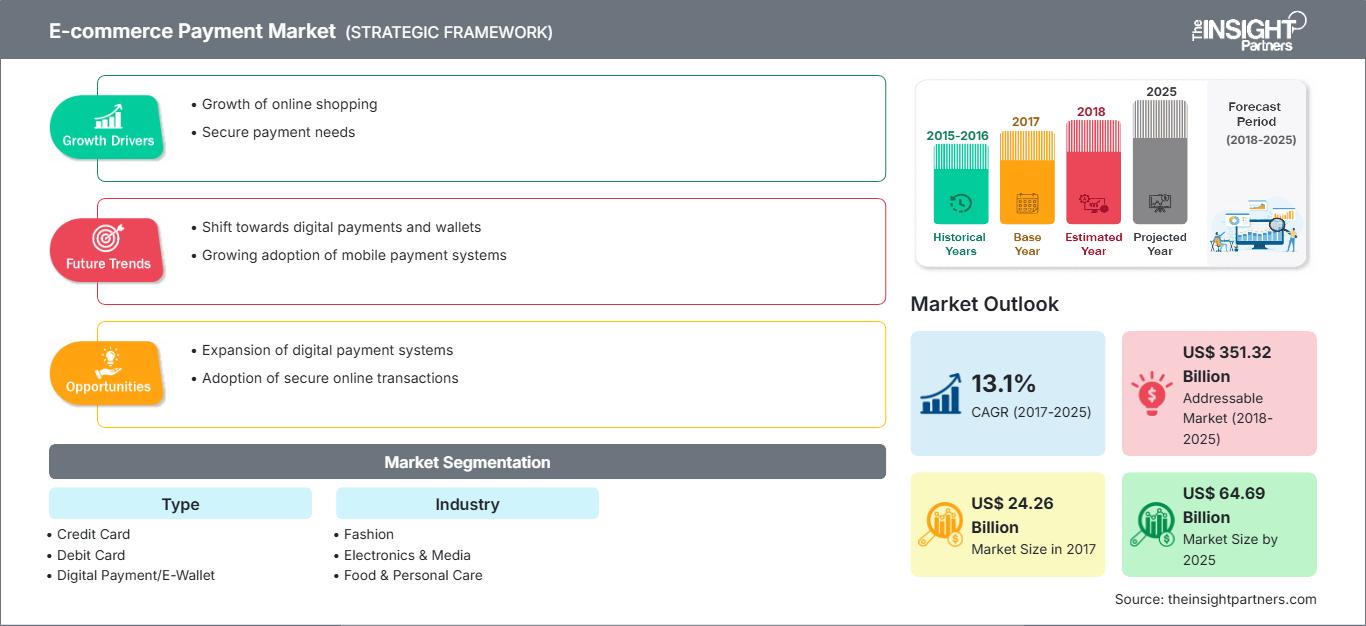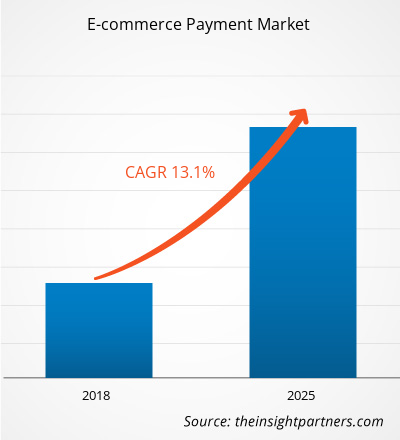世界のeコマース決済市場は、2017年の242.6億米ドルから2025年には646.9億米ドルに拡大し、2018年から2025年にかけて年平均成長率(CAGR)13.1%で成長すると予測されています。
eコマース決済市場は世界中で成長を遂げており、多様な決済手段が利用可能になったことでオンライン決済への関心が高まっています。さらに、スマートフォンの普及とインターネットの普及もeコマース決済市場の成長を後押ししています。さらに、銀行利用者の増加とデジタル化の進展により、eコマース決済市場は予測期間中に大きく成長すると予想されています。本レポートは、Eコマース決済市場をタイプ、業界、地域ごとに詳細に区分しています。
市場洞察
予測期間を通じて、アジア太平洋地域が主要地域として認識されています
アジア太平洋地域には、韓国、インド、インドネシア、マレーシアなど、いくつかの発展途上国が含まれています。これらの国では人口が急増しており、その結果、Eコマース決済市場が成長しています。この地域のEコマース業界は、インターネットの普及率向上とスマートフォンおよびタブレットの採用率向上により活況を呈しています。また、新興経済国の政府は銀行人口の改善に取り組んでおり、オンライン決済業界に優れたプラットフォームを提供しています。最近では、APAC全体の消費者が、電子ウォレット、銀行振込、クレジットカードおよびデビットカードなどの代替決済方法を介してオンラインで支払うことを好む傾向が見られます。これらの決済方法の利用増加は、予測期間中にEコマース業界の決済ゲートウェイの成長に大きく貢献すると予想されます。これらの要因により、APAC 地域の電子商取引決済市場の需要がさらに高まると予想されます。
要件に合わせてレポートをカスタマイズ
レポートの一部、国レベルの分析、Excelデータパックなどを含め、スタートアップ&大学向けに特別オファーや割引もご利用いただけます(無償)
電子商取引決済市場: 戦略的洞察

-
このレポートの主要な市場動向を入手してください。この無料サンプルには、市場動向から見積もりや予測に至るまでのデータ分析が含まれます。
世界のEコマース決済市場において、市場主導型戦略が最も採用されていると見られていました。Eコマース決済市場のプレーヤーによる最近の戦略をいくつか以下に挙げます。
2018年:PayPalはeBayとのパートナーシップ契約の延長を発表しました。この契約により、eBayはマーケットプレイスプラットフォームを通じてPayPalクレジットのプロモーションと受け入れを継続します。2018年:Alipayは今年末にヨーロッパ20カ国でサービスを開始すると発表しました。同社はヨーロッパ全域で40社以上のデジタルウォレット企業および100社の銀行と契約を締結しました。2018年:Visa, Inc.は、小売業者と消費者にとって信頼性が高く、安全で、適切なモバイルおよびデジタル決済の導入を促進するため、PayPalとのパートナーシップをカナダまで拡大すると発表しました。
電子商取引決済市場の地域別分析
予測期間を通じてEコマース決済市場に影響を与える地域的な傾向と要因については、The Insight Partnersのアナリストが詳細に解説しています。このセクションでは、北米、ヨーロッパ、アジア太平洋、中東・アフリカ、中南米におけるEコマース決済市場のセグメントと地域についても解説しています。
電子商取引決済市場レポートの範囲
| レポート属性 | 詳細 |
|---|---|
| の市場規模 2017 | US$ 24.26 Billion |
| 市場規模別 2025 | US$ 64.69 Billion |
| 世界的なCAGR (2017 - 2025) | 13.1% |
| 過去データ | 2015-2016 |
| 予測期間 | 2018-2025 |
| 対象セグメント |
By タイプ
|
| 対象地域と国 |
北米
|
| 市場リーダーと主要企業の概要 |
|
電子商取引決済市場のプレーヤー密度:ビジネスダイナミクスへの影響を理解する
Eコマース決済市場は、消費者の嗜好の変化、技術の進歩、製品メリットへの認知度の向上といった要因によるエンドユーザーの需要増加に牽引され、急速に成長しています。需要の増加に伴い、企業はサービスを拡大し、消費者ニーズを満たすための革新を進め、新たなトレンドを活用しており、これが市場の成長をさらに加速させています。

- 入手 電子商取引決済市場 主要プレーヤーの概要
世界の電子商取引決済市場のセグメンテーション
タイプ別
- クレジットカード
- デビットカード
- デジタル決済/電子ウォレット
- ネットバンキング
- ギフトカード
- その他
業界別
- ファッション
- 電子機器およびメディア
- 食品およびパーソナルケア
- 家具・家電製品
- サービス業
- その他
地域別
-
北米
- 米国
- カナダ
- メキシコ
-
ヨーロッパ
- フランス
- ドイツ
- イタリア
- スペイン
- 英国
- その他ヨーロッパ
-
アジア太平洋地域 (APAC)
- オーストラリア
- 中国
- インド
- 日本
- その他APAC地域
-
中東・アフリカ (MEA)
- サウジアラビアアラビア
- UAE
- 南アフリカ
- 中東アフリカのその他の国
-
南米(SAM)
- ブラジル
- SAMのその他の国
企業プロフィール
- PayPal Holdings, Inc.
- Amazon Payments, Inc.
- CCBill, LLC
- WePay Inc.
- Alipay
- Visa, Inc.
- MasterCard Incorporated
- Stripe Inc.
- American Express Company
- UnionPay International Co., Ltd.
- 過去2年間の分析、基準年、CAGRによる予測(7年間)
- PEST分析とSWOT分析
- 市場規模価値/数量 - 世界、地域、国
- 業界と競争環境
- Excel データセット
最新レポート
お客様の声
購入理由
- 情報に基づいた意思決定
- 市場動向の理解
- 競合分析
- 顧客インサイト
- 市場予測
- リスク軽減
- 戦略計画
- 投資の正当性
- 新興市場の特定
- マーケティング戦略の強化
- 業務効率の向上
- 規制動向への対応






















 無料サンプルを入手 - 電子商取引決済市場
無料サンプルを入手 - 電子商取引決済市場